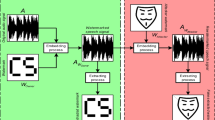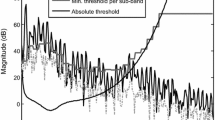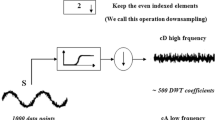Abstract
Today’s world is a domain of Social Networks with millions of people sharing valuable information over the Internet. In the future wireless networks like 5G, it is estimated that 20 billion devices will be connected with the internet (IoT). Therefore, there are certain issues related to the privacy and security of a user while sharing information through a social network especially when the shared information carries multimedia content like images, video, audio/speech. The security issues such as integrity and data authentication can be fulfilled using various Digital Watermarking Techniques. In this paper a new technique of Speech Watermarking (Least-Significant-Bit substitution) using Filter Bank Multicarrier Modulation (FBMC) Technique for 5G networks is proposed and implemented. The technique has been implemented in MATLAB on a test recorded speech signal against various signal processing modifications (FBMC and Additive White Gaussian Noise). Experimental results reveal that the proposed technique in spite of various attacks allows to retrieve embedded watermark efficiently with less Bit Error Rate and better audio quality of the received speech signal.












Similar content being viewed by others
References
Fang, J., You, Z., Lu, I. T., Li, J., & Yang, R. (2013). Comparisons of filter bank multicarrier systems. In Systems, Applications and Technology Conference (LISAT), 2013 IEEE Long Island (pp. 1–6). IEEE.
Farhang-Boroujeny, B. (2014). Filter bank multicarrier modulation: A waveform candidate for 5G and Beyond”. Advances in Electrical Engineering, Hindawi Publications, 2014.
Foo, S. W. (2008). Non-blind audio-watermarking using compression-expansion of signals. In Circuits and Systems, 2008. APCCAS 2008. IEEE Asia Pacific Conference on (pp. 1288–1291). IEEE.
Healy, R., Timoney, J. (2009). Digital audio watermarking with semi-blind detection for in-car music content identification. In: Proceedings of the AES 36th International Conference: Automotive Audio—Sound in Motion, June 2–4, Dearborn, Michigan, IEEE Xplore.
Ibrahim, A. N., & Abdullah, M. F. L. (2017). The potential of FBMC over OFDM for the future 5G mobile communication technology. In AIP Conference Proceedings (Vol. 1883, No. 1, p. 020001). AIP Publishing, Melville.
Katariya, S. S. (2012). Digital watermarking. International Journal of Engineering and Innovative Technology, 1(2), 143–153.
Liu, C. H., & Chen, O. C. (2004). Fragile speech watermarking scheme with recovering speech contents. In Circuits and Systems, 2004. MWSCAS’04. The 2004 47th Midwest Symposium on (Vol. 2, pp. II–II). IEEE.
Liu, G., & Jiang, D. (2016). 5g: Vision and requirements for mobile communication system towards year 2020. Chinese Journal of Engineering, 2016.
Matheson, L. R., Mitchell, S. G., Shamoon, T. G., Tarjan, R. E., & Zane, F. (1998). Robustness and security of digital watermarks. In International Conference on Financial Cryptography (pp. 227–240). Springer, Berlin.
Nematollahi, M. A., & Al-Haddad, S. A. (2013). An overview of digital speech watermarking. International Journal of Speech Technology, 16, 471. https://doi.org/10.1007/s10772-013-9192-6.
Nematollahi, M. A., Al-Haddad, S. A. R., & Zarafshan, F. (2015). Blind digital speech watermarking based on Eigen-value quantization in DWT. Journal of King Saud University-Computer and Information Sciences, 27(1), 58–67.
Nematollahi, M. A., Vorakulpipat, C., & Gamboa Rosales, H. (2017). Optimization of a blind speech watermarking technique against amplitude scaling. Security and Communication Networks, 2017.
Rathore, S., Sharma, P. K., Loia, V., Jeong, Y. S., & Park, J. H. (2017). Social network security: Issues, challenges, threats, and solutions. Information Sciences, 421, 43–69.
Sharma, P. K. (2012). Rajni: Analysis of image watermarking using least significant bit algorithm. International Journal of Information Sciences and Techniques (IJIST), 2, 666–673.
Sheikh, J. A., Akhtar, S., Parah, S. A., & Bhat, G. M. (2018). A new method of speech transmission over space time block coded co-operative MIMO-OFDM networks using time and space diversity. International Journal of Speech Technology, 21(1), 65–77.
Sheikh, J. A., Parah, S. A., Akhtar, S., & Bhat, G. M. (2017). Compression and denoising of speech transmission using Daubechies wavelet family. International Journal of Wireless and Mobile Computing, 12(4), 313–334.
Skourletopoulos, G., Mavromoustakis, C. X., Mastorakis, G., Batalla, J. M., Dobre, C., Panagiotakis, S., & Pallis, E. (2017). Big data and cloud computing: A survey of the state-of-the-art and research challenges. In Advances in mobile cloud computing and big data in the 5G Era (pp. 23–41). Springer, Cham.
Wang, S., Unoki, M., & Kim, N. S. (2014). Formant enhancement based speech watermarking for tampering detection. In Fifteenth Annual Conference of the International Speech Communication Association.
Author information
Authors and Affiliations
Corresponding author
Rights and permissions
About this article
Cite this article
Sheikh, J.A., Akhter, S., Parah, S.A. et al. Blind digital speech watermarking using filter bank multicarrier modulation for 5G and IoT driven networks. Int J Speech Technol 21, 715–722 (2018). https://doi.org/10.1007/s10772-018-9541-6
Received:
Accepted:
Published:
Issue Date:
DOI: https://doi.org/10.1007/s10772-018-9541-6




